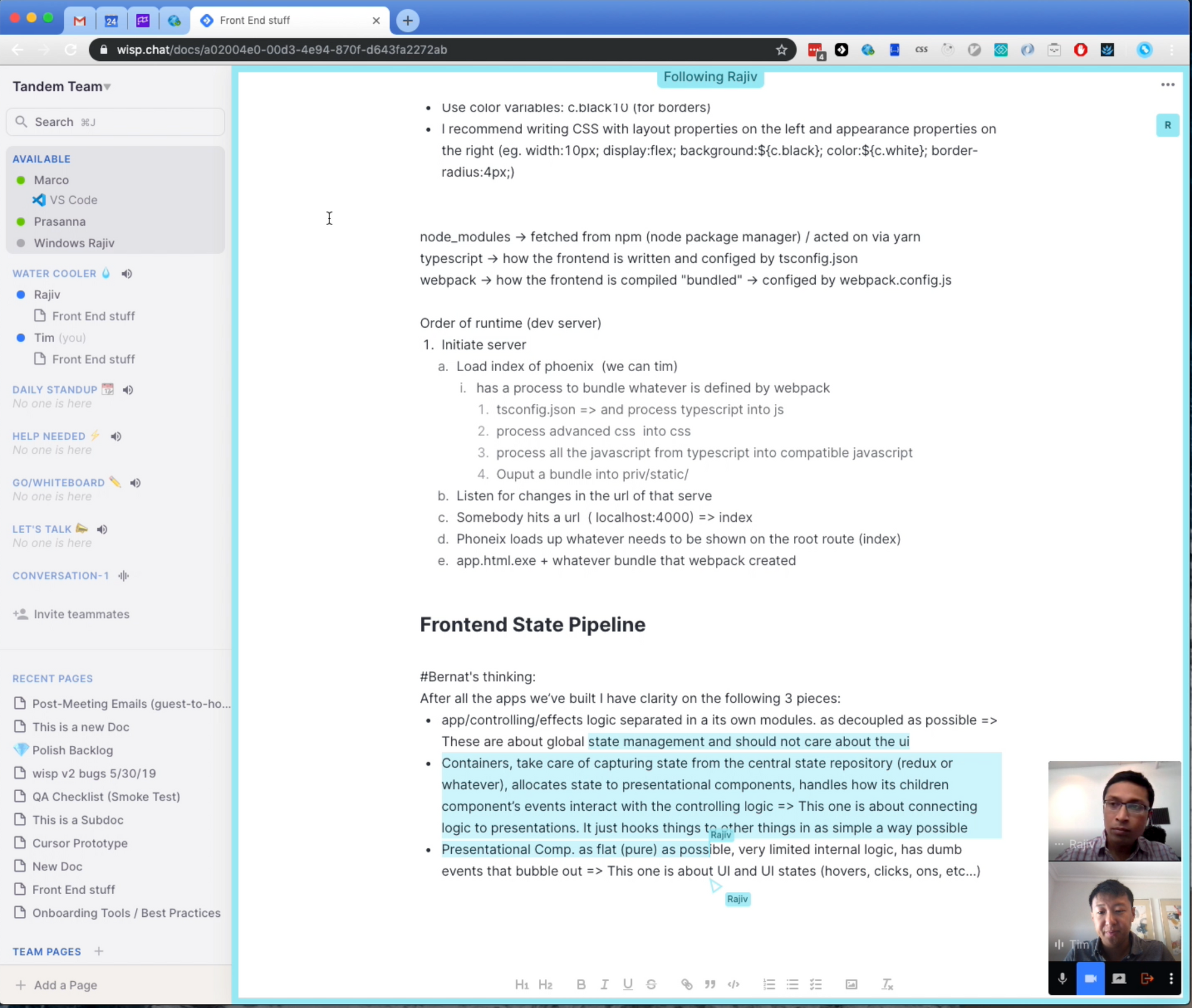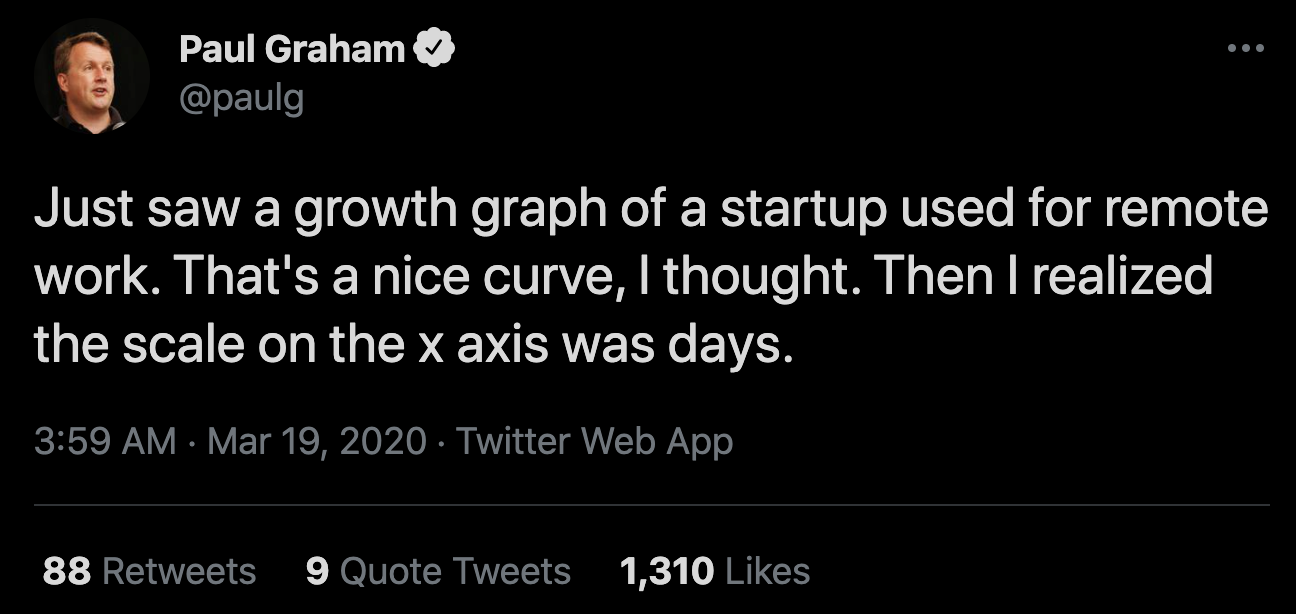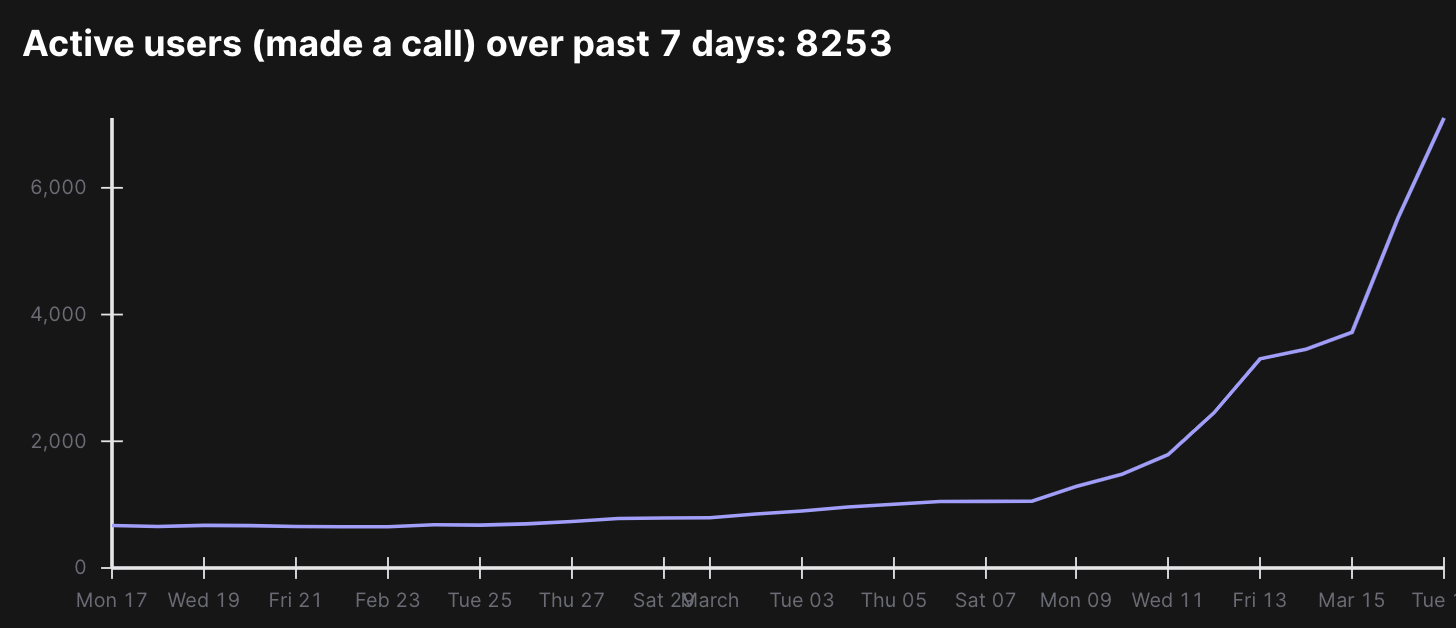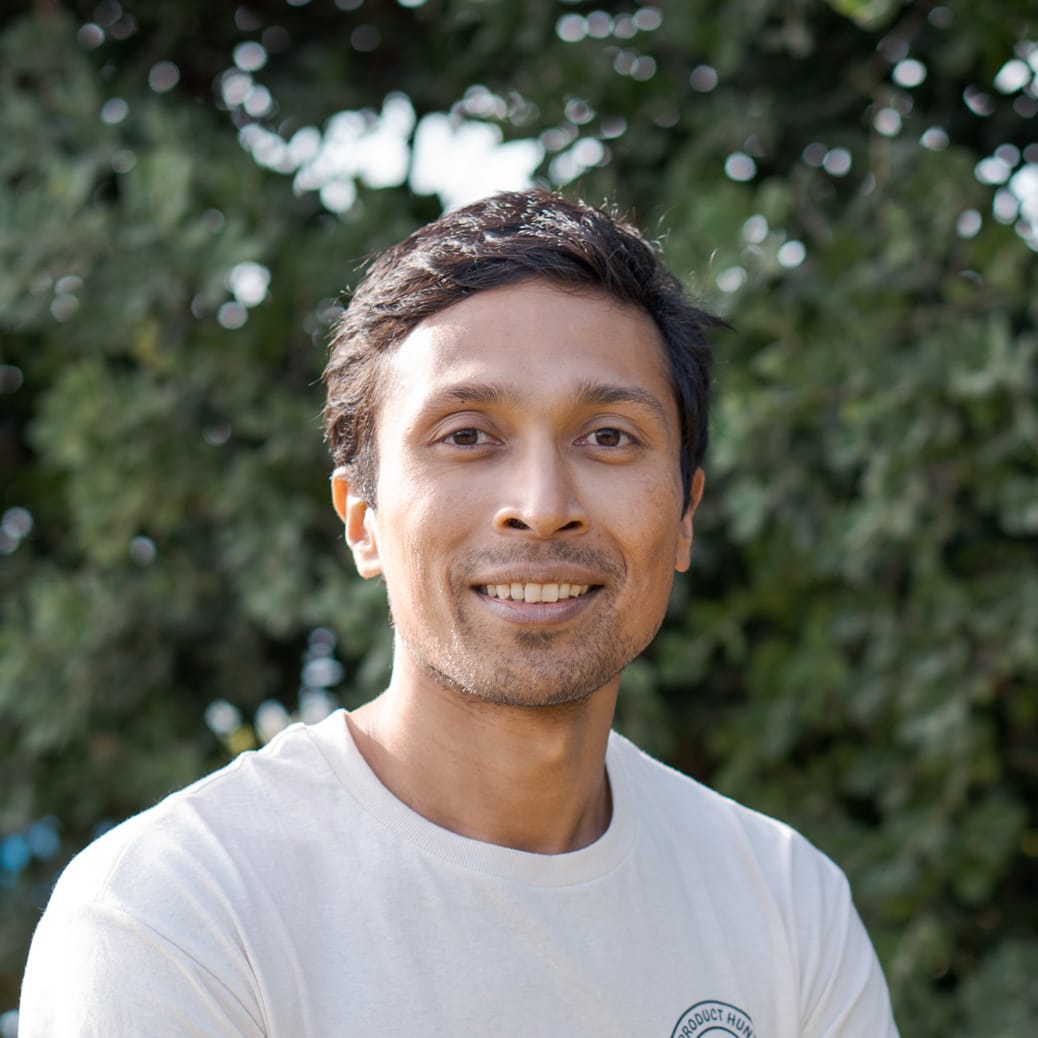Originally posted in Bookface (YC forum) as "Shutdown Bookface (kind of): Tandem S19 (virtual office)"
tldr:
We didn’t find a venture-scale market, perhaps because most people value the autonomy of remote work more than they miss the quick-syncs and high-paced collaboration of in-office work.
When our runway ended last year, instead of shutting down, we spun out an LLC and gave it over to two of our team to run. Feature velocity has slowed, but they’re able to focus on stability and incremental growth experiments.
Tandem is default alive and has even grown a little, so the story isn’t over yet.
Why write this?
It was a wild ride, and many founders have asked me what happened. We pivoted from crypto in 2018 (Cryptagon, a portfolio tracker), raised one of the hottest seed rounds in 2019 ($7.5m from a16z), created the “Virtual Office” category just before the pandemic propelled us up, struggled to grow, attempted a pivot (Hybrid Spaces), then wound down in an unusual way.
If you can relate to any of this, I hope it’s helpful to you. Also, writing this has given me some closure and opportunity for reflection. Plus, remote connection is still a global problem, and maybe this post will help someone solve it.
Navigating the idea maze
In late 2018, our portfolio tracker and subsequent crypto exchange had reached dead ends. Meanwhile, the birth of each of my co-founders' children led us to work remotely.
We'd been friends at Yahoo, and started the company mainly to work with each other. After a year working closely in person, remote work felt like an airplane crash-landing into the sea. We felt disconnected, our collaboration sluggish. None of the tools we tested could replicate the flow of working in-person, so we started building.
Our first attempt was "Round Table," a way of configuring Discord to mimic co-working at the same table. Initial teams loved the spontaneous chats, but they rarely happened, and most found Discord's gaming emphasis confusing.
Encouraged, we built a few prototypes in quick succession:
- A walkie-talkie app was quick and easy to use, but often teammates were unavailable.
- To reach unavailable teammates, we built an "answering machine" feature that simultaneously recorded and transmitted audio. But users hated voice messages.
- Changing tack, we tried to enforce availability by integrating your work with video chat. We built a Figma-inspired document editor with voice and video attached.
Teams resisted switching to a new editor, especially one prone to multiplayer glitches. But they appreciated the sense of "presence" - if Tim's in a doc, I know he's online and free to talk. They also loved the Figma-like shared cursors, and had fun chasing each others' cursors around the docs.

From my design co-founder, Bernat:
The UI started to get complex. We tried to fit magical things into small spaces…In Google docs or Figma you can follow a person. We tried to extend that concept beyond the current artifact. What if you could follow someone anywhere they are in their work environment? Very much like walking around the office with your thinking partner. It felt like a big breakthrough.
In reflection, these features feel magical and meaningful when you use them, but the frequency of use is low, and they come at a high cost of product complexity…I think we gave ourselves the freedom to add complexity to the product. Another company would have been more ruthless about simplicity, we weren’t, for good or for bad. (see his full post on the design evolution, with screenshots)
Our next iteration was the early version of Tandem. We removed our brittle docs, and expanded presence to show which work-apps were in focus - similar to how Discord shows which games your friends are in. We added shared cursors to screen share, and built a chrome extension that drew shared cursors on apps like Jira and Notion - making them feel multiplayer.
The Virtual Office
We took this prototype to YC, where our initial Bookface launch fell flat. People didn't understand or resonate with our description - “an instant collaboration tool (desktop app + Chrome extension) that goes way beyond calling.” Still, a dozen teams believed in us and gave it a shot.
From Bernat:
Holding all that complexity was not just making me sink hours into Figma, but also affecting users. I started feeling the need to be a lot more extreme with letting go of features, simplifying, and keeping only the key things that people liked.
Few made it through onboarding—you had to install both a desktop app for video calls and a Chrome extension. We wrestled with whether to cut one of these entirely, and ultimately teams found video calls more essential than shared cursors. Simplifying the product quadrupled our signup rate!
Meanwhile, the constant question "What are you building?" from batchmates and YC partners, along with a promise-testing framework Bernat and I developed (maybe a future post), helped us nail our tagline: "The virtual office for remote teams, where you can see who’s around and talk in one click." All of a sudden, people seemed to understand what we were building and why.
We hit #1 on Product Hunt, and Hacker News brought in lots of teams. When Patrick Collison gave us a shoutout on Twitter, the influx crashed our app. Hundreds of remote teams were signing up, mostly through word-of-mouth. We had a classic hockey stick, though many teams churned soon after signup.
We felt like the world wanted what we were building, if we could just deliver on the promise.
A hot round
Despite the poor retention, the fundraise was white-hot. It got weird. People gave us crazy gifts, like a blue tandem bicycle. In 10 days we went from largely unknown founders to 7 term sheets, culminating in an outsized $7.5m seed from a16z and a dream roster of angels.
Our Demo Day pitch was wildly ambitious at the time: "Every company is a remote company," because every company becomes distributed as it scales (multiple offices, travelers, working-from-home). We had discovered a secret about the future, and now everyone else was starting to see it. It felt like we’d created a new category of software - over the next year, several other 'virtual offices' raised even larger rounds.
When we closed the round, I felt relief - all fundraising is stressful, and hot rounds are stressful in their own way. At the same time, I felt the pressure and stakes increase dramatically. My dad - also a founder - put it concisely: "Congratulations! Now the work really begins."
The Pandemic - promise-market fit
Before our first engineering hire even started, the pandemic hit.
Michael Seibel has said that product-market fit "feels like getting punched in the face repeatedly." The first month of the pandemic felt like that. Every metric went exponential. Thousands of companies - seemingly every unicorn and Fortune-500 - installed Tandem. There was a single day when we doubled in active users. Despite Tim's herculean efforts, we had frequent outages, and lots of video call failures. We were absolutely drowning in user complaints.


We felt like the world needed Tandem. But churn was high. We weren't delivering on the core promise of unlocking spontaneous calls. After the initial spike, churn took over and we started declining.
Over the next year, we delivered on that initial promise. We made dramatic improvements to UX and presence. Through relentless user testing, the interface became less weird and more useful. We also put massive effort into call quality and reliability, building our own WebRTC stack along the way.
Tandem was working as we imagined for more and more teams, and it was beautiful to see. It unlocked spontaneous calls - 50% of calls were under 15 minutes. We logged over 3M call hrs. 3-month retention increased 2.5x. We started growing again.
But a few months later, we flattened. The top-of-funnel had dried up. Over the next year, we tried everything - growth features, paid acquisition, direct sales, product marketing. We could influence most stages of the funnel, but it didn't translate to getting full teams onboard. It felt like people just didn't want Tandem anymore.
On the surface, there were several reasons for this market shift:
- Slack Huddles fulfilled part of our use case
- Video fatigue (globally, video calls fell by 2/3 after the initial pandemic spike - video burnout was real).
- Many Tandem teams returned to the office.
But I think there’s a core insight here, around how I want the world to work vs. how it actually works (thanks to Michael Waxman for this framing):
I wish we all wanted to talk with our team frequently and collaborate closely. But, most people don’t feel a need to talk to their co-workers that often. They value the autonomy and convenience of remote work, even if it can lead to disconnection and loneliness. The companies that value close collaboration have returned to the office or hybrid models.
For some companies, Tandem resonates, and it’s beautiful to see it working. But that market is small (~250 companies as of now).
With our remaining runway, we made an ambitious pivot around hybrid work (hardware devices that let remote teammates teleport around the office), but it led to almost no actual sales. We had an inspiring solution, and tried to shape the market, but we couldn’t.
Why didn’t we keep fighting?
The simple answer is - we were out of runway, in part because we opted for an ambitious pivot instead of cockroach mode. A deeper answer is that we'd reached a natural end as a founding trio.
Bernat left before our pivot, for a variety of reasons, but primarily to work on climate tech. It was a difficult process, and I felt a tremendous sense of loss, but ultimately it was better for him, and we’re still close friends.
Meanwhile, Tim and I learned we weren't the easiest co-founders for each other. We're quite different in mindset, and this often caused tension - although usually productive. For example, I wanted an intensely focused company culture, while Tim wanted a collaborative environment where engineers could do their best work. We remained committed because we saw how these contrasts led to better decisions as a founding team. However, when faced with starting over from scratch, we realized maybe this isn’t what we wanted to do.
I still count Bernat and Tim as close friends, and trusted sounding-boards, and I can 1000% recommend them as co-founders. If the stars align and you get to work with them, do it.
We all grew in myriad ways over the 5-year journey. I learned to recognize the emotional armor I sometimes carried - the defensive need to be right, instead of finding the right answer collaboratively. I learned ways of letting go of this armor and getting to a place of curiosity. I learned the value of separating the story in my head from reality, and from the other person's story - the space between our narratives is breathing room for connection.
Of everything the startup journey has given me, I value these lessons the most.
Why didn’t we sell / do an acqui-hire?
In parallel to the pivot, we looked to sell. Despite the fantastically poor timing (just as hiring freezes were going into effect) we ran a process, and had a couple offers at the end.
We all wanted to work together, and it would have been a nice outcome for the founders, but the offers weren’t great for our team. Also, Tandem would have been shut down, which would have stranded our customers.
We ultimately decided to create a separate LLC, which we gave to two of our team (Akash and Billy) to run as a small business. The rest of the team either took a much-needed break or found a job they’re excited about.
I’m grateful to Akash and Billy for having the vision for keeping Tandem independent. They also drove the latest pricing strategy and rollout (we barely churned any teams). As a result, Tandem (the product) is default-alive and thriving!
Feelings of failure
While I'm satisfied with how we wound down, the months preceding were some of the darker times in the startup journey for me. I struggled with feelings of failure on multiple fronts.
A strategic acquisition was never guaranteed, but when we weren’t able to find even a viable acquihire option, I felt I had let the team down.
When Bernat left, I felt like I'd failed him as a co-founder. Since we started 5 years ago, I'd held a vision of the three of us ringing the IPO bell together. I didn’t just want to win, I wanted us to win together.
With some distance and reflection, and trading notes with other founders, I can see these as part of the normal startup rollercoaster. The failure of Tandem to find a larger audience, on the other hand, still feels a bit personal. If you know me, you know one of my core values is co-creation - thinking together with others, and the other is unlocking potential in myself and others. In hindsight, Tandem was an expression of these values, and using it made my life so much better.
When the world didn’t want Tandem, it felt like the world didn’t want me.
The silver linings
I feel proud, and quietly, deeply satisfied, that Tandem still unlocks remote connection for hundreds of companies.
Although the final outcome wasn't what we hoped for, I'm proud of how we planned ahead and reacted quickly to changing market conditions. We quickly went through plans A (raise), B (pivot), C (sell), D (wind down) to the best of our abilities. Through it all we prioritized what was important: In this type of outcome: Team > Customers > Investors.
On a lighter note, I’ve had some great heart-to-heart conversations with former competitors, where I can really share everything I learned in hopes they succeed. Unsurprisingly, we see the world in similar ways, and have felt similar market whiplash. Shout out to Teamflow (now Lindy.ai), Switchboard, and Remotion!
What I’d do differently
When the pandemic hit and we felt like we had product-market fit, I wish we'd continued to work on top-of-funnel growth, and testing adjacent markets and distribution strategies (like direct sales). When the market shifted, it took us a long time to feel it, because we'd been out of touch with how we were growing. In the future I'll be more paranoid, even when I think I've found PMF.
On the team front, I wish we'd worked in-person as much as possible, especially in the early days of the company. While Tandem makes remote work dramatically better, it’s still far from the high-bandwidth collaboration you can have in-person. In fact, I’ve come to believe in-person work is like a team superpower.
On the life-balance front, I wish I hadn't stopped rock climbing during the stress of the pandemic. It was important to me before, and I lost a part of myself when I stopped.
What’s next
I’m back in co-founder mode, working with Vikrum Nijjar, Sam Odio, and Drew Houston at Dropbox building a new productivity tool in time and calendar management - reach out if you’re interested!
Tim Su is working on experiments around AI coding, document workflows, and teamwork, and Bernat is building a geo-mapping tool for reforestation projects.
I'm also carving out some time to help startups. If any part of my story resonates, I’m happy to chat. We had so much help along the way, I’d love to pay it forward.
End Credits
Thank you
- to everyone in the YC Community who believed in us. Especially our group partners Gustaf Alstromer, Dalton Caldwell, Aaron Epstein, and Holly Liu
- to everyone who believed in Tandem - the story’s not over yet!
- to our awesome coach, Anamaria Niño-Murcia
- to our investors, especially David Ulevitch and the a16z team, who set a high bar for the kind of investors I want to work with
- to Kwin and Nina from Daily.co for helping us get off the ground and being friends throughout the journey
- to our S19 batchmates! Monaru, Goldfig, FeaturePeek, Intersect, Sherlock, Carry, Mighty, and too many others to list
